
 Department Homepage
The College of Arts & Sciences
Department Homepage
The College of Arts & Sciences
‘Paths to Peace’ explores legacy of antiwar campaigner
On June 12, 1982, an estimated one million people marched through the streets of New York City to protest the nuclear arms race between the United States and the Soviet Union. They had a simple proposition: immediately freeze the development and deployment of nuclear weapons. Then, they argued, we can begin the hard work of eliminating them altogether.




